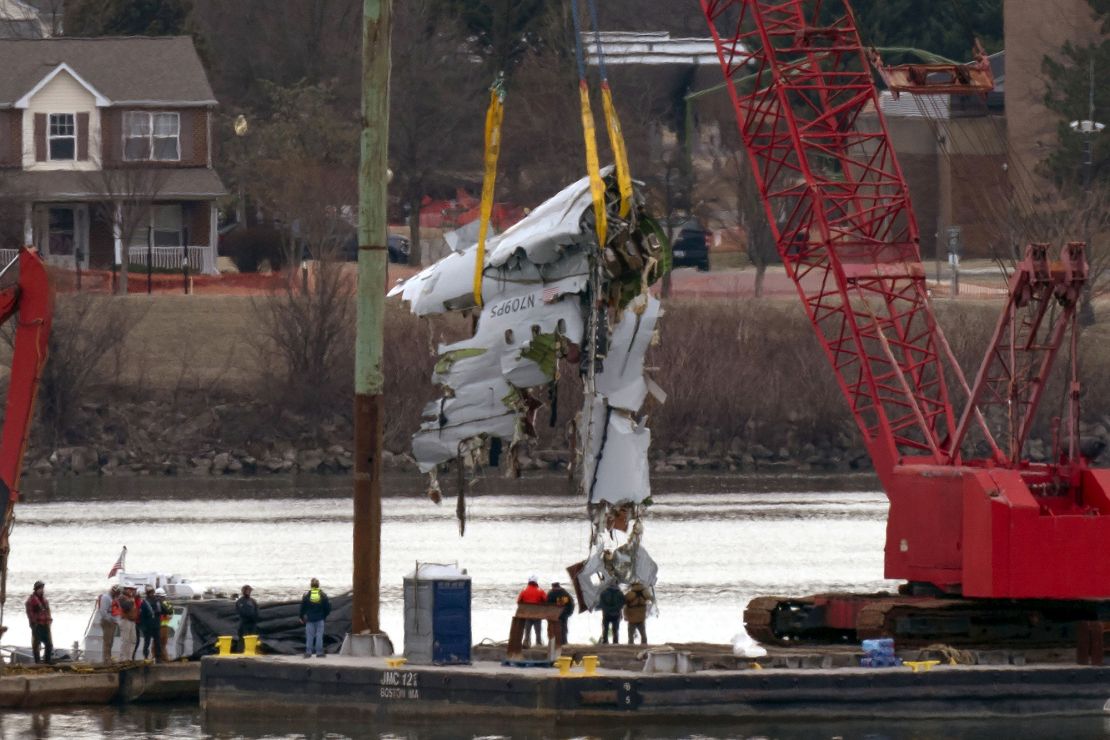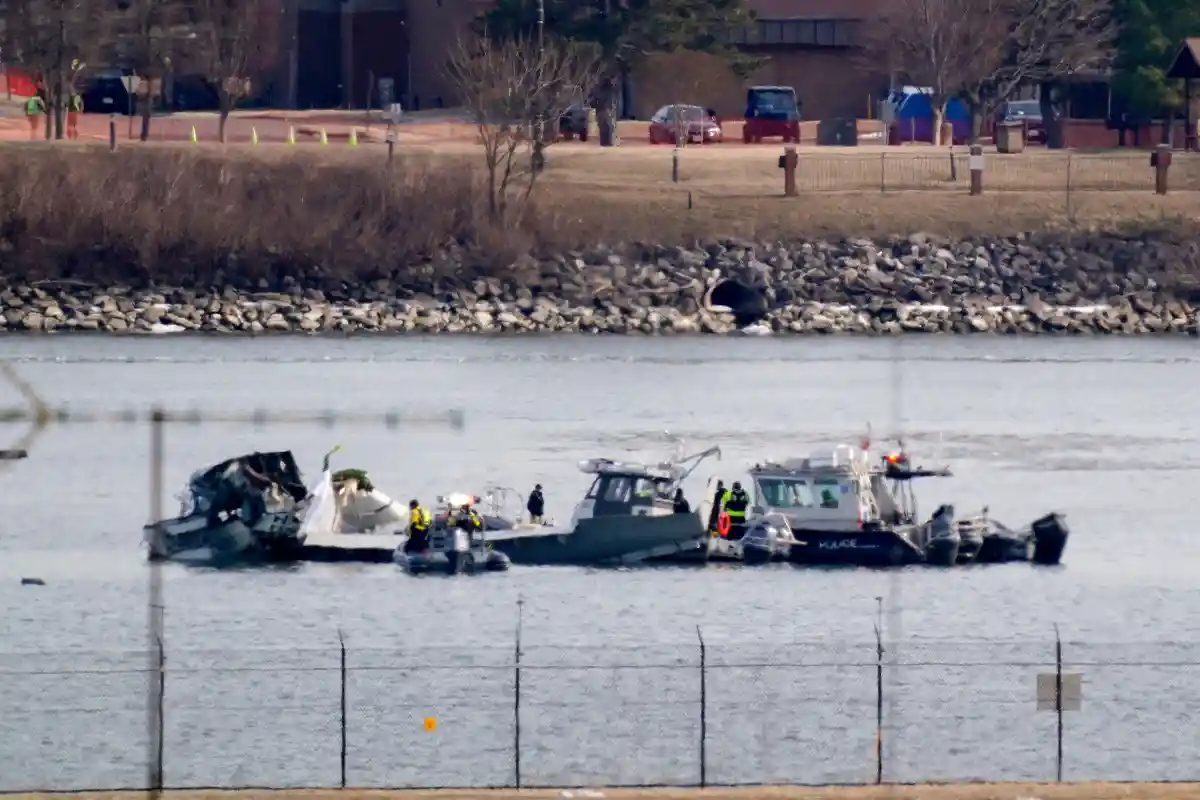The Bombardier CRJ700 jet operating as American Airlines Flight 5342 and an Army Black Hawk helicopter on a training mission ran into each other over the river nearly a week ago in an accident that remains unexplained.
More parts of the plane – which will also form pieces of the puzzle investigators are trying to solve – were pulled from the river Tuesday morning. One section of the plane’s fuselage lay sideways on a barge, a row of cabin windows visible. By afternoon, the plane’s tail – with its distinctive red, white, and blue livery – was removed from the murky water.
Officials have said they would likely recover the American Airlines cockpit later Tuesday, wind gusts and tidal levels permitting. As of Tuesday, 66 of the 67 victims recovered have been identified.
For the second day in a row Tuesday, the National Transportation Safety Board – which has been reviewing data from the Black Hawk’s flight data recorder that was recovered over the weekend – backed away from announced plans for a public briefing on its investigation.
“NTSB needs additional information to verify data points from the Black Hawk,” the agency said in a post on X, adding that a written update would be released later in the day.
President Donald Trump spoke to American Airlines CEO Robert Isom by phone Monday, a source familiar with the call told CNN. The White House did not comment Tuesday on what was discussed.
CNN obtained a memo from Isom to employees confirming the call with Trump. In it, Isom says the president called to “share his condolences for our crew members, passengers and their loved ones.” The note also says he asked Isom to relay his “personal appreciation” for the work of airline employees supporting the families.
The airline will observe a moment of silence Wednesday to mark one week since the fatal collision, according to the note from Isom.
As a salvage team continues to work in cold winter conditions to lift debris from the frigid water, key questions about the cause of the fatal collision remain –– though answers may not be immediately clear for weeks.
The former director of the FAA’s Office of Accident Investigation, Steven Wallace, said he’s confident the cause of the disaster will eventually be unambiguous.
“We have radar data, we have eyewitnesses, and we have all the wreckage,” Wallace told CNN’s Phil Mattingly. “Nothing is missing.”
By Wednesday, inclement weather will bear down on Washington, with snow, sleet and freezing rain expected to worsen already tough conditions for recovery personnel.

An arduous and slow recovery mission
The mangled wreckage in the Potomac has made the recovery effort especially difficult for dive teams, who have struggled to access parts of the plane’s fuselage.
Divers have been using specialized underwater hydraulic rescue tools capable of cutting metal, but heavier salvage equipment is required to get jet parts out of the way and out of the water.
The recovery effort has been extensive, involving nearly every dive team in the area, including those from the US Coast Guard, the FBI’s Washington Field Office dive team, DC Fire and the International Association of Fire Fighters.
A new phase of recovery began Monday after divers spent the weekend getting a view of the underwater debris to map out a plan to recover the jet wreckage.
The NTSB on Monday said the agency is working to get the airplane out first, before the helicopter, a Sikorsky UH-60 Black Hawk, which will take four days longer.
But Monday’s work was painstaking and slow.
A jet engine was the first to be lifted from the frigid water, slowly raised by a crane. Video taken from shore showed salvage workers guiding it gently to the deck of a barge. From a distance, most of the engine’s cowling and exhaust nozzle appeared intact.
Two hours later, a second piece of the plane was pulled out –– a jagged portion of the fuselage not immediately identifiable.
Dean Naujoks, the Potomac Riverkeeper for the past 10 years, was granted access to the site of the crash to help investigators search for debris, according to CNN affiliate WRAL.
Naujoks recovered a window panel, a seat, insulation, an airplane manual, and a bag of sugar packets. Everything was covered in jet fuel, he said.
“It was just the saddest day I’ve ever been on the river,” Naujoks told WRAL. “My heart goes out to all the families of the victims.”

Airplane flight data recorder and helicopter black box reveal new clues
The American Airlines flight data recorder shows the plane’s nose came up just before the fatal collision, an analysis by the NTSB found.
“At one point very close to the impact, there was a slight change in pitch, an increase in pitch,” NTSB member Todd Inman said at a Saturday evening news conference.
The airplane’s flight data recorder gives an altitude reading of about 325 feet at the time of impact, Inman said, but air traffic controllers never had an indication the helicopter went above 200 feet.
A key question in the investigation has been focused on whether the Black Hawk helicopter was higher than the 200-foot altitude limit it was supposed to observe as it flew a designed route along the eastern bank of the Potomac.
The NTSB released early findings from the probe Tuesday that say radar displays in the airport’s control tower showed the helicopter at 300 feet before the collision. The radar altitude data is rounded to the nearest hundred feet, the NTSB said in a written investigative update.
The helicopter corridor in use at the time carried an altitude restriction of 200 feet, the NTSB said. The update is more in line with data from one of the airline’s so-called black boxes.
The NTSB said it pulled the Potomac TRACON – or terminal radar approach control – data to help resolve a discrepancy in the initial readings from the radar data gathered for the investigation.
That discrepancy, according to Jennifer Homendy, chair of the NTSB, could be because the radar at Ronald Reagan Washington National Airport is updated every five seconds, allowing for significant movements within that frame.
“There’s a lot that occurs in five seconds, especially when a helicopter is moving at a pretty good clip,” she said Monday after they recovered the helicopter’s black box.
“They’re taking that data and making sure that it’s accurate, that the time stamps are right to try to marry it up with the (black box) data from the plane to provide that information publicly,” she said.
Later Monday, the NTSB said the flight data recorder for the Black Hawk did not have timestamps and investigators would have to manually create them. A preliminary report from the NTSB will likely be published in a month.
CNN’s Pete Muntean and Alexandra Skores reported from Washington, DC; Karina Tsui wrote from Hong Kong and Andy Rose wrote from Atlanta.














